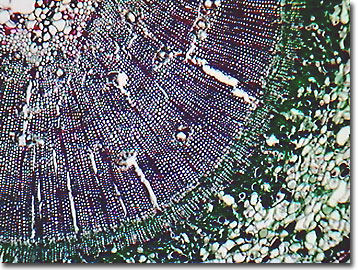Brightfield Digital Image Gallery
Pine Stem Thin Section
The pine family (Pinaceae), which contains over 50 species in cultivation in the United States, represents a group of magnificent evergreen species that have tremendous value both as ornamentals and as timber trees. Almost all pines have a continuous trunk that displays whorls or tiers of branches, with deviant branches only randomly and rarely appearing outside the whorl.

View a low magnification image of the pine stem.
View a high magnification image of the pine stem.
View a highest magnification image (possible with the MIC-D) of the pine stem.
The yellow or loblolly pine, Pinus taeda, displays needle-like leaves that are borne in sheathed clusters of three, and grow 6 to 9 inches long. The cones range from 3 to 5 inches in length and have long scales with very sharp points. Although the yellow is not the most beautiful of pine trees, it is tolerant of a wide range of soil conditions, and is seldom seriously affected by insects or diseases. Young yellow pines grow rapidly, reaching a height of 90 feet at maturity.
Chief uses for wood from the southern pine family are pulpwood, hard and particle board, poles, mine timbers, pilings, railroad ties, veneer and construction plywood, structural timbers, building construction (all phases), boxes, baskets, mill products, woodenware, novelties, paving blocks, tanks, and silos. Although usually grown in even-stand plantations with greatly reduced habitat diversity, many species of birds and mammals thrive in woods dominated by yellow pines.
When examined under the microscope in thin section, pine tree specimens reveal an abrupt transition from spring to summer wood. Tracheids average 35 to 45 micrometers in diameter, and bordered pits occur in a single row, or paired on the radial walls. Longitudinal parenchyma is lacking, and the rays are of two types: uniseriate and fusiform. Resin canals have thin-walled epithelium and are frequently occluded with tylosoids in the heartwood of yellow pines. Although not well studied, older pine trees exhibit senescence by reducing or eliminating cone formation, and this aging process is reportedly accelerated by air pollution.
Contributing Authors
Cynthia D. Kelly, Thomas J. Fellers and Michael W. Davidson - National High Magnetic Field Laboratory, 1800 East Paul Dirac Dr., The Florida State University, Tallahassee, Florida, 32310.
BACK TO THE BRIGHTFIELD IMAGE GALLERY
BACK TO THE DIGITAL IMAGE GALLERIES
Questions or comments? Send us an email.
© 1995-2025 by Michael W. Davidson and The Florida State University. All Rights Reserved. No images, graphics, software, scripts, or applets may be reproduced or used in any manner without permission from the copyright holders. Use of this website means you agree to all of the Legal Terms and Conditions set forth by the owners.
This website is maintained by our
Graphics & Web Programming Team
in collaboration with Optical Microscopy at the
National High Magnetic Field Laboratory.
Last Modification Friday, Nov 13, 2015 at 01:19 PM
Access Count Since September 17, 2002: 7872
Visit the website of our partner in introductory microscopy education:
|
|
